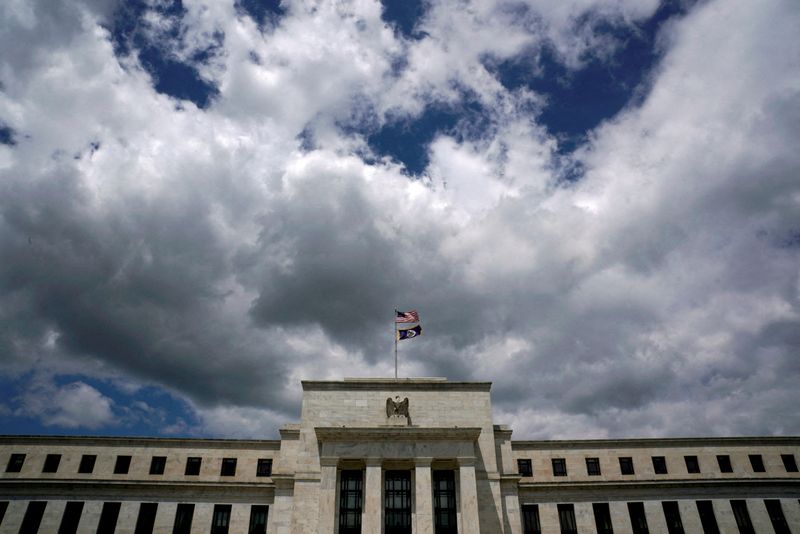
© Reuters. Flags fly over the Federal Reserve Headquarters on a windy day in Washington, U.S., May 26, 2017. REUTERS/Kevin Lamarque/File Photo
LONDON(Reuters) – Major central banks are now signalling that interest rates will likely move lower in coming months as inflation weakens, calling time on what of what has been the most aggressive tightening cycle in decades.
The United States, UK and Sweden all left rates steady this week, with the U.S. Federal Reserve saying it sees lower rates on the horizon.
Traders expect the Fed and ECB to start easing around the mid-year mark, while outlier Japan could finally hike rates soon.
Here’s how big central banks stand, ranked in terms of the rate hikes in the recent tightening cycle.
1) UNITED STATES
The Fed held rates steady at 5.25% to 5.5% on Wednesday.
Chair Jerome Powell said interest rates had peaked and would move lower in coming months as inflation continues to fall.
However, he stopped short of a declaring victory in the central bank’s two-year inflation fight, dampening investor hopes for rate cuts as soon as the March 19-20 meeting.
Traders now anticipate a first cut in May, with 144 bps of easing in total priced in by year-end.
2) NEW ZEALAND
The Reserve Bank of New Zealand held interest rates at a 15-year high of 5.5% in November and is expected to hold again at its Feb. 28 meeting before cutting as early as May.
Inflation came in below the central bank’s 5% forecast in the final quarter of 2023.
3) BRITAIN
The Bank of England kept rates at a nearly 16-year high on Thursday but softened its stance about when it might cut them, while one of its policymakers cast the first vote for a reduction in borrowing costs since 2020.
Still, with two members of the BoE’s Monetary Policy Committee voting for a rate hike, markets tempered their rate cut bets. Traders now see a roughly 50% chance of a quarter point cut in June, down from 64% before the BoE decision.
4) CANADA
The Bank of Canada held rates at 5% on Jan. 24 for the fourth consecutive meeting.
It said that while underlying inflation was still a concern, the bank’s focus was shifting to when to cut borrowing costs rather than whether to hike again. Markets fully price in a quarter-point cut by June.
5) EURO ZONE
The ECB left rates unchanged at a record high on Jan. 25, but a slightly softer stance on inflation gave markets a hint it was starting to contemplate policy easing.
Money markets reckon the ECB could be the first big central bank to cut rates, with traders pricing in a roughly 90% chance of a quarter point rate cut for April, and around 140 bps in total by year-end.
6) NORWAY
The Norges Bank, which delivered a surprise December rate hike, kept its key rate unchanged at 4.50% on Jan. 25 and said borrowing costs would stay on hold “for some time ahead”.
Norwegian core inflation fell to a 15-month low of 5.5% in December. A strengthened Norwegian crown should soften import prices.
7) AUSTRALIA
The Reserve Bank of Australia held rates steady in December at 4.35%. Minutes of the meeting showed it had considered hiking again although markets are now pricing cuts from September.
Data in January showed business conditions and inflationary pressures were softening while Australia remains vulnerable to shaky economic conditions in China, its major trading partner.
8) SWEDEN
Sweden’s central bank, which left its key rate steady at 4% on Thursday, says it might be able to bring forward the timing of a first rate cut if inflation continues to slow.
Economists reckon the Riksbank will start easing in May or June.
9) SWITZERLAND
A strong Swiss franc, up 5% versus the euro since early 2023, has dampened price pressures in a nation that could be heading for early rate cuts.
Inflation undershot the Swiss National Bank’s (SNB) 2% target for the seventh straight month in December. SNB chairman Thomas Jordan has said there is no need for more hikes from the current 1.75% level.
10) JAPAN
The Bank of Japan maintained its ultra-easy monetary settings on Jan. 24 but signalled conditions for phasing out its huge stimulus were falling into place, suggesting it could soon end negative interest rates.
Economists polled by Reuters expect the BOJ to make this move by April. Japan’s core inflation slowed for a second consecutive month in December but remained above its 2% target.
>>> Read full article>>>
Copyright for syndicated content belongs to the linked Source : Investing.com – https://www.investing.com/news/economy/big-central-banks-are-pivoting-towards-rate-cuts-3290043































